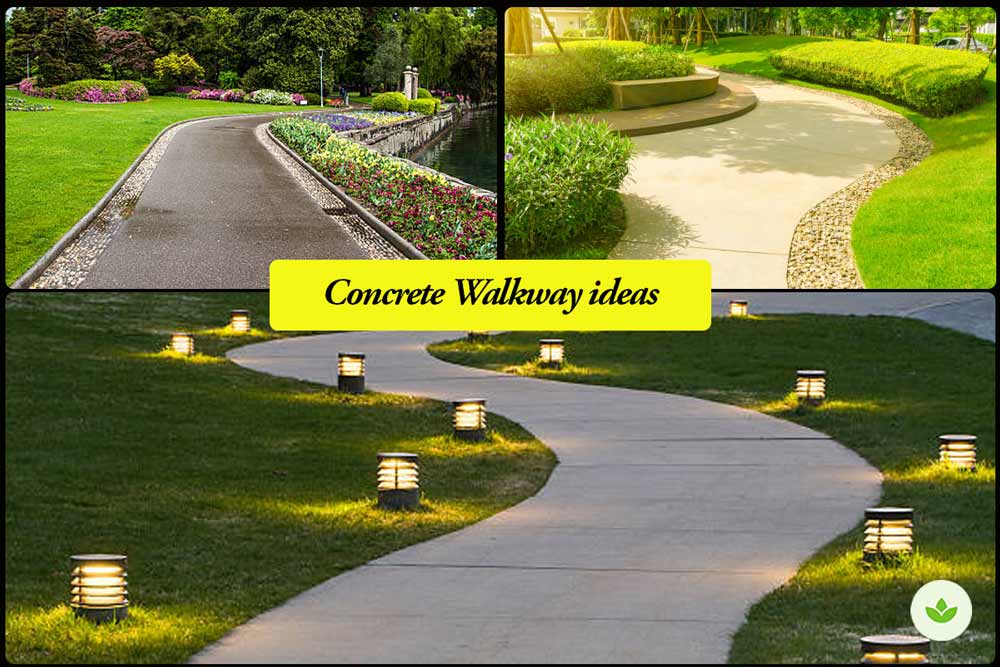Being a liquid, concrete’s creative uses are infinite. No other paving material is so fluid; no other paving is, in fact, a fluid.
You can cast concrete into any shape imaginable for the creation of straight or curving, narrow or wide paths from the house into the garden; you can make decorative panels or faux millstones to place at a gateway or break in a hedge; you can tint, paint or stain the wet cement so the color of the walkway blends with architecture; you can give concrete innumerable finishes or patterns.
A concrete pathway can be scored to look old; pebbles or tiles can be embedded to form decorative patterns in the path; the surface of a walkway can be marbleized or polished or made into false coquina (coral reef) stone.
Concrete can be combined with any number of materials to form steps or ramps into which planting pockets can be built. In the hands of an artist, it can mimic rock outcroppings and boulders through a garden; it will take any form, such as water rills and channels the length of walkways.
Concrete is a contemporary product often associated with modern homes in warmer climates; stucco homes or Spanish Revival. The decision to use concrete or not is based on the material and style of your home. Next to a white clapboard house, a brick home, or a stone house, concrete would look flat, cold, and out of place.
How to use concrete
- Plain walkways to the front or side doors.
- Paths laid wet and then embedded with pebbles or tiles at some point that require special attention.
- Stepping stones.
- Steps with gaps that can be backfilled with soil and planted with drought-tolerant plants such as lavender.
Because you work with concrete in its soft (cement mix) form, you can use it to create almost any look you want. Concrete can be curved and formed into myriad shapes, used on steep slopes, poured into molds to create pavers, textured, colored, or even decorated with anything from embedded crushed tile to shells.
In just a day or so after pouring, it hardens into a durable walkway that will last for many years (depending on such variables as the weather, the firmness of the base, and the kind of traffic).
One caveat: once the concrete is set, there isn’t much you can do to change the design without breaking the path to pieces and starting over.
Concrete path ideas
1. Embedded Materials
Small stones, tiles, marble, seashells, or glass can be embedded into concrete to make a decorative panel in a walkway. This adds interest to a garden on even the dullest of overcast days.
Throughout Spain, Portugal, and many other Mediterranean countries, the practice of embedding pebbles in a mix of sifted clay, soil, and water is very much a part of the national style of gardening.
Pebble mosaics and other decorative panels can be used to slow or even stop people at points along the path where you want to concentrate their attention not only on the embedded panels but on some other elements in the garden: a special view, an unusual plants, a bench, chair or sculpture.
One pebble mosaic may be formal and geometric, and the next one gentle and feminine.
Before mixing and pouring concrete into the path, lay all the tiles, pebbles, or whatever you want to embed nearby so you are ready. Then mix the concrete, perhaps using a retardant to slow the hardening process, and pour into the path until it is up to the appropriate level.
Wearing rubber gloves to prevent your fingers from coming into contact with the concrete, push-in pebbles, or whatever materials is in use.
Depending on the mix, you will have around an hour before the concrete becomes so hard that you can’t press materials in any longer.
Once the materials are in place, a board can be laid across the path to tamp the pebbles or tiles uniformly into the concrete. As the concrete begins to harden, brush with a horse broom to expose the surface of the pebbles and gently wash the pebbles clean.
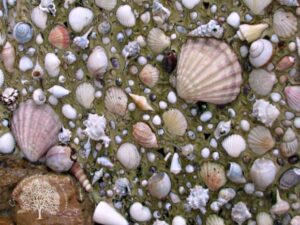

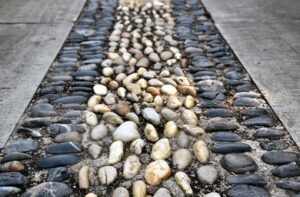
2. Concrete as stepping stones
Concrete can also be poured in situ to create stepping-stone walkways. The stepping stones also form niches for creeping plants, mosses, or turf that make a garden extraordinary.
And by allowing the concrete to crack, or by scoring it intentionally, you can make the material look stone-like and aged.
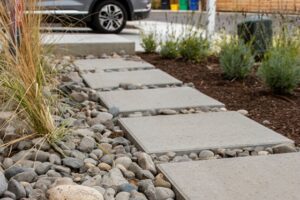

3. False Coquina stones
Coquina is a southern Florida coral reef stone once quarried off the Keys.
Because of increasing concern about offshore ecology, sophisticated methods have been developed for creating a concrete copy of coquina stone called Buff Keystone.
Henry Herpel and a company called Manyon Precast in West Palm Beach have both developed these systems. You can purchase the “faux coquina” from them. In some cases, they imprint the faux coquina with real stones.
You can also make a surface that mimics natural coquina stone. Lay a 3 to 4-inch thick slab of cement and let it harden so that it is about half an inch or less below the desired finished grade. Mix a fresh batch of cement, dip a broad mason’s brush into it, and splatter it into the cured slab. This hardens for half an hour and then with a wooden mason’s float, flatten the little peaks left by the splattering. This results in a look that is very similar to that of natural coquina stone.
An even simpler method is to pour the wet concrete slab up to the finished grade and then immediately scatter baking soda on the surface. This method pits and mars the surface. When the surface is dry, it is hosed off, revealing pitting that is very similar to the natural coquina.
Score marks to mimic the cut panels of the coquina can also be drawn directly onto the drying cement with a screwdriver.

4. Colored Concrete
White or colored pigments or aggregates can be added to concrete to give a wide range of colors and textures.
Pigments can be purchased by color from building supply outlets as a powder: brick red, black, brown, natural red, medium red, cement black, brownstone brown, green, yellow, orange, and gold are all available and can be combined to form any number of variations.
Add tinting agents to the concrete mix before pouring it, the color is permanent because it is in rather than on the concrete.
If you want to color existing cement, you can use paints designed for outdoor concrete work, but the paint will not penetrate the cement the way a concrete pigment will. These tend to bleach out in hot sunlight, but they do hold better in shady parts of the garden.
Colored gravel, colored sands, pieces of brick or crushed tile can also be scattered onto wet concrete or into the concrete mix to color the finished surface while adding texture.
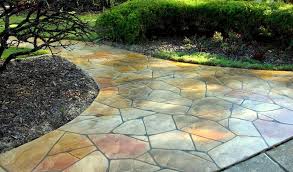

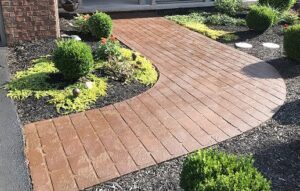
5. Stamped/Imprinted concrete
Another interesting innovation is imprinted concrete, which creates the effect of cobblestones, fieldstones, or bricks. Special equipment is required to create the imprint, so it is generally best laid by contractors.

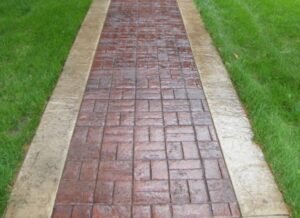

6. Textured concrete walkway
To create an exposed aggregate look and feel for the surface of your path, mix decorative gravel with the wet cement, then wash away the finished surface of the concrete with a stiff spray of water a day or two after pouring it.
Timing the wash-off is critical; test boxes should be used for experimenting first. If you spray the surface too early, too much concrete will wash out, leaving a pitted look. If you wait too long. the concrete will not wash out, leaving an unattractive surface of concrete covering most of the decorative gravel.
As another option, rock salt can be pressed into wet cement, then dis-solved with the hose a couple of days after the concrete is set.



